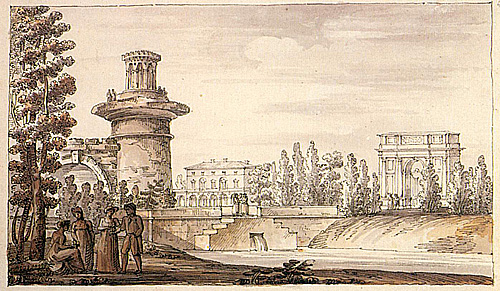Ruin Tower on:
[Wikipedia]
[Google]
[Amazon]

 The Ruin Tower () is an 18th-century monument in Ekaterininsky Park of
The Ruin Tower () is an 18th-century monument in Ekaterininsky Park of
 A Gothic pig-iron gate can be found at one end of the embankment. It was cast on J.M.Felten's model in 1782 at the Demidovsky factory in Ekaterinburg. It is notable as one of the first architectural products to be found in Russia made of pig-iron.
A Gothic pig-iron gate can be found at one end of the embankment. It was cast on J.M.Felten's model in 1782 at the Demidovsky factory in Ekaterinburg. It is notable as one of the first architectural products to be found in Russia made of pig-iron.
 The Ruin Tower () is an 18th-century monument in Ekaterininsky Park of
The Ruin Tower () is an 18th-century monument in Ekaterininsky Park of Tsarskoye Selo
Tsarskoye Selo ( rus, Ца́рское Село́, p=ˈtsarskəɪ sʲɪˈlo, a=Ru_Tsarskoye_Selo.ogg, "Tsar's Village") was the town containing a former residence of the Russian imperial family and visiting nobility, located south from the cen ...
- now Pushkin
Alexander Sergeyevich Pushkin (; rus, links=no, Александр Сергеевич ПушкинIn pre-Revolutionary script, his name was written ., r=Aleksandr Sergeyevich Pushkin, p=ɐlʲɪkˈsandr sʲɪrˈɡʲe(j)ɪvʲɪtɕ ˈpuʂkʲɪn, ...
, a suburban town in eponymous borough
A borough is an administrative division in various English-speaking countries. In principle, the term ''borough'' designates a self-governing walled town, although in practice, official use of the term varies widely.
History
In the Middle Ag ...
of St. Petersburg, Russia. It was designed and constructed in 1771-1773 by German-Russian architect Yury Felten.
History
The tower was erected in remembrance of heroic battles of the Russo-Turkish War of 1768–1774 by request of Catherine II. The civil works were conducted by architect I. M. Sitnikov. The powerful stone tower, in the form of a column of Tuscan order, is topped by a roundarbour
Arbor(s) or Arbour(s) may refer to:
Arts and entertainment
* ''Arbor'' (installation), a 2013 public artwork in Indianapolis, Indiana, US
* Arbor, a counterweight-carrying device found in theater fly systems
* ''The Arbor'', a 1980 play by Andr ...
upon the abacus at a height of 21 metres. Views of the nearby lake and surrounding park can be observed through the arbour's Gothic lancet apertures.
In the summer of 1773, artist A. Belsky painted the external walls of the tower ruins and cracks have been cut in the plastered surface to simulate natural damage. In 1784, trees were planted along the edge of the embankment upon which the tower was sited. The tower's huge stone arch
An arch is a vertical curved structure that spans an elevated space and may or may not support the weight above it, or in case of a horizontal arch like an arch dam, the hydrostatic pressure against it.
Arches may be synonymous with vaul ...
at its base enhances an impression that it extends deeply into the earth.
 A Gothic pig-iron gate can be found at one end of the embankment. It was cast on J.M.Felten's model in 1782 at the Demidovsky factory in Ekaterinburg. It is notable as one of the first architectural products to be found in Russia made of pig-iron.
A Gothic pig-iron gate can be found at one end of the embankment. It was cast on J.M.Felten's model in 1782 at the Demidovsky factory in Ekaterinburg. It is notable as one of the first architectural products to be found in Russia made of pig-iron.
Restoration
The first major repair of the tower was in 1883. In the Second World War, it sustained damage from shelling, causing fragmentation, hollows and cracks in the arches and eaves and major damage to the travertin. The arbour was half-destroyed. A restoration plan was formulated in 1977 but inspection and clearance work did not begin until 1986. Experts of a joint venture between " Lenpolproekt" and the " Lenproektrestavratsiya" institute carried out design work and, from 1993, the Polish firm PKZ (Workshops on Restoration of Ancient Monuments) was appointed ascontractor
A contractor is a person or company that performs work on a contract basis. The term may refer to:
Business roles
* Defense contractor, arms industry which provides weapons or military goods to a government
* General contractor, an individual o ...
. The restoration was completed in 2006 and the pavilion was re-opened in August 2009. Now incorporated into a museum garden, it is open to the public daily from 11 am to 5 pm.
References
{{Coord, 59, 42, 35, N, 30, 23, 2, E, display=title Buildings and structures in Pushkin Towers completed in 1773 Ruins in Russia Towers in Saint Petersburg Cultural heritage monuments of federal significance in Saint Petersburg